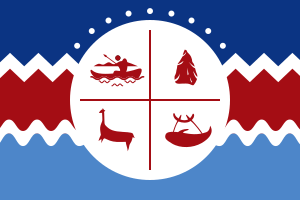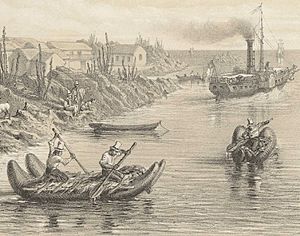Chango people facts for kids
| Chango | |
|---|---|
 |
|
| Total population | |
| ~4,725 people declared | |
| Regions with significant populations | |
| Coast of Atacama Desert | |
| Related ethnic groups | |
| Mapuche? |
The Changos (also called Camanchacos or Camanchangos) were a group of indigenous people. They lived along the Pacific coast, from southern Peru down to north-central Chile. This included the dry Atacama Desert coast.
Sadly, much of their culture and way of life has disappeared. For a long time, people thought the Changos were extinct. But in 2020, Chile officially recognized them as an original indigenous group. Today, about 4,725 people in Chile identify themselves as Chango.
Contents
Who Were the Changos?
The Chango culture began with the 8,000-year-old Chinchorro tradition. Over time, the Changos mixed with other cultures. This led many to believe their culture had disappeared. However, as mentioned, they are now officially recognized in Chile.
The term "Chango" didn't mean one single tribe or ethnic group. Instead, it described many different groups of indigenous people. They lived along the northern Chilean and southern Peruvian coast before Christopher Columbus arrived. Spanish explorers first used the word "chango" in the 1600s. They saw that these coastal groups lived in similar ways. So, "chango" describes people who shared a way of life, not necessarily a common history.
The Chango culture is linked to the Chinchorro tradition. The Chinchorro people were hunter-fisher-gatherers. They relied a lot on the sea. They lived along the Atacama coast from at least 800 BC. They are famous for their unique practice of mummifying the dead.
Some Changos living near Paposo around 1870 spoke a dialect of Mapudungun. This is the language of the Mapuche people from south-central Chile. Some place names on the coast of the Antofagasta Region, like Taltal, might even come from the Mapuche language.
How the Changos Lived and Traded
Chango communities were either nomadic (moving around) or sedentary (staying in one place). They were organized into small family groups. Each group was independent and found its own food and resources.
Fishing and Hunting
The Changos were very skilled at using the sea's resources. Each group often specialized in catching certain types of fish. These included tuna, conger eels, mullet, and octopus.
They used different kinds of rafts for fishing. At first, they used simple rafts made of reeds. Later, they built rafts from three wooden planks. Their most advanced rafts were made from seal skins sewn together and attached to wooden frames. They caught fish using nets, hooks, and harpoons.
Hunting seals was very important to the Chango way of life. They used every part of the animal. The meat, fat, and bones were used for food and tools. Seal skins were used to make rafts. Even the intestines were used to make fishing gear.
Tools and Crafts
Besides seal skins, the Changos used other materials. They used vicuña wool, feathers, bird skins, shells, and the bones and teeth of sea creatures. They turned these into useful and beautiful items. These included clothing, blankets, tools, cutlery, and jewelry. They also made and painted ceramic pots and dishes.
Trade and Art
Even though they lived in isolated coastal areas, the Changos traded with tribes further inland. They exchanged seafood like shellfish and dried fish. They also traded animal hides, guano (bird droppings used as fertilizer), fat, and shells. In return, they received wool, fruit, maize (corn), and coca leaves from the inland tribes.
Chango cave paintings show scenes of daily life. These include men hunting and fishing. They also show sea creatures like seals, turtles, and whales.
See also
 In Spanish: Changos para niños
In Spanish: Changos para niños



